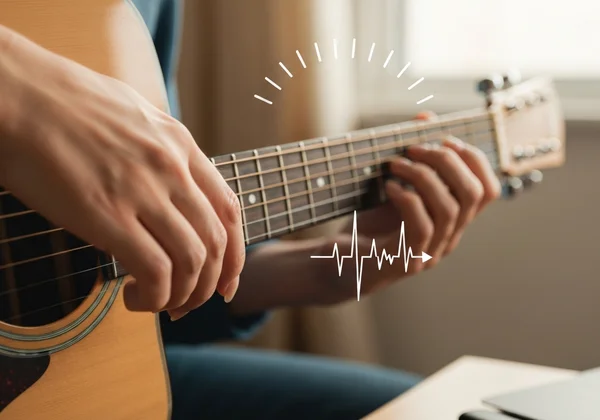Master Rhythm with Our Online Metronome: Your 7-Day Beginner Plan
Starting your musical journey or honing your existing skills often comes with a common recommendation: "Use a metronome!" But for many, especially absolute beginners, this advice can feel intimidating. The constant, unforgiving click can seem more like a critic than a partner. How can I use a metronome effectively as a beginner? This guide is here to answer that question, providing an ultra-simple, day-by-day plan to demystify metronome practice and build your rhythm confidence from scratch. Let this online resource be your patient, precise guide to developing an unshakable sense of timing.
Getting Started: How to Use Your Metronome Tool
Before we dive into the daily exercises, it’s essential to get comfortable with your new rhythm partner. Understanding the tool and its purpose is the first step toward transforming your relationship with time. This isn’t about being perfect immediately; it’s about building a solid foundation. We'll start with the basics to ensure you feel confident and ready for the week ahead.
What is a Metronome & Why is it Essential for Beginners?
At its core, a metronome is a device that produces a steady, consistent click at a specific speed. Think of it as the ultimate timekeeper. For beginners, its value is immeasurable. Music is built on the foundation of rhythm, and a metronome provides an external, objective source of truth for your timing. It helps you develop an internal clock, ensuring you don’t unintentionally speed up or slow down while playing. This steady pulse is the bedrock of your entire musical journey.
Setting Up Our Online Metronome: Your Free Rhythm Partner
Forget bulky physical devices or expensive apps. Your journey begins with a simple click of a button. Our platform offers a professional-grade, highly customizable metronome directly in your browser—completely free and without ads. There's nothing to download or install. Just visit the homepage and you’re ready to go. Before starting Day 1, take a moment to explore your free online metronome. Notice the large display, the slider to adjust the speed, and the start button. It's designed to be intuitive so you can focus on what matters: your practice.

Understanding BPM: Your First Tempo Setting
You'll see the letters "BPM" prominently displayed on the metronome. This stands for Beats Per Minute, and it’s the universal measurement for tempo, or the speed of a piece of music. A setting of 60 BPM means the metronome will click exactly 60 times in one minute—or one click every second. A higher number means a faster tempo, while a lower number means a slower one. For our beginner plan, we will start with a very manageable tempo setting to build a strong foundation.
Your 7-Day Beginner Metronome Practice Plan
Here is your actionable, step-by-step plan. Each day builds upon the last, taking you from simply feeling the beat to playing with rhythmic accuracy. The goal is consistency, not perfection. Aim for 5-10 minutes of focused practice each day. Open our online metronome tool and let's begin!
Day 1: Finding the Pulse at 60 BPM
Today’s goal is simple: listen. Navigate to our platform and use the slider or buttons to set the BPM to 60. Press "Start" and just listen to the steady click. Close your eyes. Tap your foot along with the beat. Nod your head. Feel the pulse in your body. Don’t clap or play an instrument yet. The entire exercise is about internalizing this steady, one-click-per-second rhythm. Do this for five minutes.
Day 2: Clapping Simple Quarter Note Rhythms
Set your metronome to 60 BPM again. A quarter note is the most basic rhythmic value in music; it gets exactly one beat. Today, you will clap your hands precisely on every single click. Strive for your clap to merge with the metronome's sound, becoming one. This exercise trains your physical coordination to match an external pulse. Focus on the consistency of your quarter note rhythms. If 60 BPM feels too slow, you can try 70 or 80, but the key is to stay perfectly in time.
Day 3: Playing Single Notes in Time (Any Instrument)
It's time to bring your instrument into the mix. Whether you play guitar, piano, violin, or drums, the principle is the same. Choose a single, comfortable note to play. Set the metronome to 60 BPM and play that one note precisely on each click. Listen carefully. Is your note starting exactly with the click, slightly before, or slightly after? The goal is perfect alignment. This exercise directly connects the concept of rhythm to the physical act of making music.

Day 4: Exploring Half & Whole Notes with Your Metronome
Let’s expand our rhythmic vocabulary. A half note is held for two beats, and a whole note is held for four. Set the metronome to 60 BPM. First, practice half notes: play a note on click one, and let it ring through click two. Play the next note on click three and let it ring through click four. Next, try whole notes: play a note on click one and count "1-2-3-4" before playing the next note on the following "1". This teaches you not just when to start a note, but how long to hold it—a crucial skill for musicality.
Day 5: Introducing Eighth Notes and Basic Subdivisions
This is a fun challenge! Eighth notes are twice as fast as quarter notes; you fit two of them into a single beat. Set the metronome to a slow 60 BPM. For every click you hear, you will clap or play two notes evenly spaced. It helps to count out loud: "One-and, Two-and, Three-and, Four-and." The numbers fall on the click, and the "ands" fall exactly in between. Mastering eighth notes and basic subdivisions is a huge step toward rhythmic fluency. Give the tap tempo feature a try to find a comfortable speed.

Day 6: Combining Rhythms & Playing Simple Melodies
Now, let's make some music! Take a very simple melody you know, like "Twinkle, Twinkle, Little Star" or "Mary Had a Little Lamb." These tunes are mostly made of the quarter and half notes you’ve already practiced. Set the metronome to a comfortable speed (perhaps 70 or 80 BPM). Try to play the melody in perfect time. This integrates all the skills from the previous days into a real musical context, showing you the practical power of your practice.
Day 7: Self-Assessment & Goal Setting for Future Practice
Congratulations, you've completed your first week! Today is about reflection. Set the metronome to 60 BPM and run through the exercises from Days 2, 3, and 5. How do they feel compared to the first time? More comfortable? More accurate? Identify what felt easy and what remains a challenge. Now, set a goal for next week. Maybe it's practicing the same plan at 65 BPM, or exploring the 3/4 time signature on our versatile metronome. This reflection ensures your practice remains purposeful.
Beyond Week One: Continuing Your Rhythm Journey
Your first week is just the beginning. The true magic happens when metronome practice becomes a consistent part of your routine. Like any skill, rhythmic precision develops over time with steady effort. Here’s how to keep the momentum going.
Troubleshooting Common Beginner Metronome Challenges
It's normal to hit a few roadblocks. Many beginners feel like the metronome is "rushing" them or find it hard to get back on track after a mistake. If this happens, the solution is always the same: slow down. Lower the BPM until it feels comfortable again. Another of the most common metronome challenges is boredom. To combat this, try changing the metronome sound on our tool or practice with a song you love, using our tap tempo tool to match its speed.
Making Metronome Practice a Lifelong Habit
The secret to incredible rhythm isn't one marathon practice session; it's five minutes of focused work every single day. Make it a non-negotiable part of your warm-up routine. By making metronome practice a lifelong habit, you are investing in the most fundamental skill in music. It will pay dividends in every note you ever play, giving your music clarity, power, and professionalism.

Your Next Steps with Our Online Metronome
You've built a solid foundation. Now, it's time to explore. Use our customizable rhythm tool to experiment with different time signatures like 3/4 (waltz time) or 6/8. Try gradually increasing the BPM on exercises you've mastered. The journey to rhythmic excellence is ongoing, and our tool is here to support you every step of the way.
Your Rhythm Journey Continues!
Congratulations on a successful first week! You've built a robust foundation for rhythm, precision, and musical confidence. By transforming the metronome from an intimidating click into a reliable musical partner, you've taken a crucial step towards mastering your timing.
Remember, consistency is the key to unlocking your full rhythmic potential. Keep practicing with our free online tool, experiment with different BPMs, and enjoy the incredible journey of becoming a more solid, confident, and expressive musician. Ready for your next session? Start your practice now!
Frequently Asked Questions About Beginner Metronome Practice
What is a good BPM for beginner metronome practice?
A great starting point for any beginner is between 60 and 80 BPM. This range is slow enough to allow your brain to process the beat without feeling rushed, making it ideal for building muscle memory and accuracy. As you get comfortable, you can gradually increase the speed by 4-5 BPM at a time.
How can I use a metronome effectively as a beginner?
The most effective way is to be consistent and start simple. Follow a structured plan like the 7-day guide above. Always start at a speed where you can play perfectly, even if it feels incredibly slow. The goal is accuracy first, then speed. Using a simple, accessible tool like our online metronome removes barriers and helps you focus.
Can practicing with a metronome truly improve my rhythm?
Absolutely. It's one of the single most effective ways to improve your rhythm. A metronome provides instant, objective feedback on your timing. It forces you to be honest about your internal clock and systematically trains it to be more precise and steady over time.
What does BPM mean in music, and why is it important for new players?
BPM stands for "Beats Per Minute" and it is the universal standard for indicating tempo, or the speed of a piece of music. Understanding BPM is crucial because it allows you to play music at the intended speed and helps you communicate with other musicians. Mastering tempo control is a fundamental skill for every new player. You can use our tool to find any BPM you need.